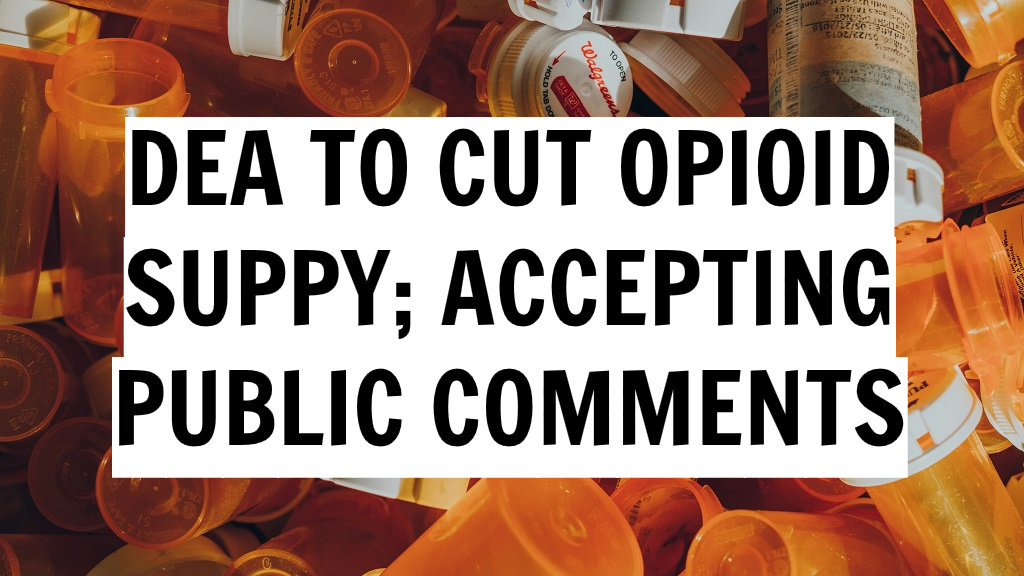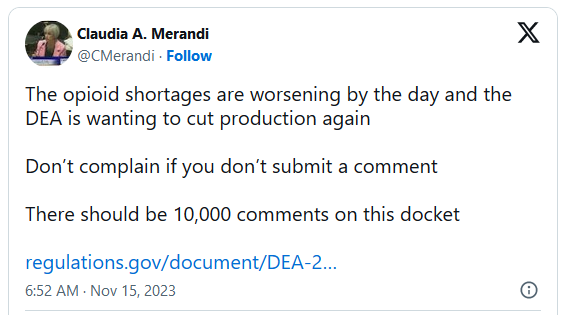
The Drug Enforcement Administration (DEA) is threatening to cut the supply of opioids at a time when pain patients are struggling to access treatment, and illicit opioids are becoming more potent. The DEA is receiving public comments on the proposed cuts at this link: https://www.regulations.gov/document/DEA-2023-0150-0001 . Comments are due by December 4, 2023.
The Controlled Substances Act gives the DEA the power to control the manufacturing and distribution of scheduled prescription drugs. According to an analysis by Pain News Network, DEA proposes the following cuts for 2024:
- – 8.3% Codeine
- – 7.6% Rx Fentanyl
- – 4.3% Morphine
- – 2.1% Hydromorphone
- – 0.3% Oxycodone
- – 0.3% Hydrocodone
Pain patient advocate and Doctor Patient Forum co-founder Claudia Merandi is encouraging her followers to submit comments.

As of this publishing, 2178 comments have been posted in the Federal Register.
One comment by Lynda Price, M.D. criticizes the DEA’s premise for these proposed cuts.
I am a retired board certified pain management physician and also happen to be a chronic pain patient. I believe that the three basic assumptions that the DEA is making to estimate diversion of drugs is highly flawed…
The institution of PDMP’s [Prescription Drug Monitoring Programs] nationwide has truly decimated the ability of doctor shopping. https://www.ncbi.nlm.nih.gov/pmc/articles/PMC8232848/ . This study found that at present only .7% of pain patients are able to doctor shop and 60% of these only do it once. The nation has done a good job of stopping this practice and so the DEA proclaiming that this is a problem that merits decreasing the supply of opioids is specious at best.
The second diversion problem that the DEA is following is “overprescribing” of opioids over 240 MME [morphine milligram equivalents]. While it is stated that this level of dosing is often necessary with cancer patients, the DEA is ignoring that the rates of new cancer diagnoses have been rising substantially. https://news.harvard.edu/gazette/story/2022/09/researchers-report-dramatic-rise-in-early-onset-cancers/ Thus, there will be more people needing the 240 MME and I saw no place in the discussion for accounting for these new cancer patients. It appears that as more patients require opiates in larger quantities, the DEA will consider this to be diversion, rather than the appropriate treatment for these folks.
Finally, patients who pay cash for opiates are not necessarily diverting drugs. Utilizing insurance to pay for opiates has become so burdensome, it is often easier for patients to just pay out of pocket. Anecdotally, my own insurance went to only approving weekly doses of narcotics for me. I couldn’t find ANY hydrocodone at any pharmacy in a 50 mile radius just north of Chicago…When I finally found a Mariano’s pharmacy with hydrocodone, I [willingly] paid for the month’s supply.
…The end result of denying pain patients their medications will most certainly result in more overdoses as patient resort to buying illegal drugs and more pain patients will simply commit suicide rather than face cold turkey withdrawals. It is not within the purview of the DEA to make up fraudulent assumptions that lead to the constraint of production of needed drugs. Why isn’t the narcotic shortage even listed on the FDA website?
Comment posted to https://www.regulations.gov/document/DEA-2023-0150-0001, Tracking # lon-6eex-l2dy
Further exacerbating the problem, the United Nations Office on Drugs and Crime (UNDOC) reported a 95% decrease in opium production in Afghanistan in 2023. As demand for opioids is unlikely to decrease, the risk of overdose from illicit synthetic opioids, that are toxic at smaller doses than opiates derived from the poppy flower, is likely to increase.
Synthetic opioids themselves are likely to become more potent. In a deal brokered by President Biden, China agreed to further crack down on the export of fentanyl and its precursor chemicals for the illicit US market. Vice News reports that this could further exacerbate, rather than reduce, the overdose problem:
“It’s probably only a question of time before much more toxic and devastating xylazine mixed with fentanyl also takes over the West Coast retail markets, and that will happen faster if wholesale fentanyl supplies become more expensive or difficult to get,” said Philippe Bourgois, professor of psychiatry and anthropology at the University of California at Los Angeles
A kratom criminalization would be the final nail in the coffin, leaving few options for pain patients desperate for any kind of treatment. A federal bill introduced in October would prevent FDA from placing tighter restrictions on kratom than on dietary supplements, and would compel the federal government to research kratom.
At the beginning of 2023, Maia Szalavitz wrote an essay published in the New York Times, mentioning Anne Fuqua, who at the time had chronicled 935 suicides of pain patients who could not access treatment.
Patients who are abandoned to withdrawal and untreated pain have an increased overdose death risk, nearly 300 percent, and their risk of suicide is also significantly elevated. If thousands of them hadn’t been cut off in the first place, the enormous street fentanyl market that now exists might have been minimized rather than given rocket fuel. It is both cruel and nonsensical to increase patients’ risk of overdose death and suicide in an attempt to reduce these harms.
As Szalavitz notes in the essay, the DEA had already reduced the 2023 opioid supply by 5%.

i am so glad they are giving those who need it a chance to speak up